1. Διακοπές στην Αθήνα

Η Αθήνα είναι η ιστορική πρωτεύουσα της Ευρώπης με μια πολύ μακριά και μεγάλη ιστορία που χρονολογείται από τον πρώτο οικισμό στη νεολιθική εποχή. Τον 5ο αιώνα π.Χ. (Η χρυσή εποχή του Περικλή) – το αποκορύφωμα της μακριάς, συναρπαστικής ιστορίας της Αθήνας – οι αξίες και τον πολιτισμό της πόλης απέκτησαν παγκόσμια σημασία. Η πολιτική σκέψη, το θέατρο, οι τέχνες, η φιλοσοφία, η επιστήμη, η αρχιτεκτονική, μεταξύ άλλων μορφών διανόησης, έφτασαν στο επικό απόγειό, σε μια περίοδο πνευματικής ολοκλήρωση μοναδικό στην παγκόσμια ιστορία.
Η Αθήνα ήταν η μήτρα του δυτικού πολιτισμού. Μια σειρά από ελληνικές λέξεις και ιδέες, όπως η δημοκρατία, αρμονία, μουσική, μαθηματικά, τέχνη, γαστρονομία, αρχιτεκτονική, λογική, Έρως, ευφορία, μεταξύ άλλων, εμπλούτισαν πολλές γλώσσες και ενέπνευσαν πολιτισμούς.
Το 1834 η Αθήνα έγινε πρωτεύουσα του σύγχρονου ελληνικού κράτους. Η επιλογή έγινε με βάση τη συμβολική σημασία της κλασικής ιστορίας της Αθήνας. Σε δύο αιώνες από τότε η Αθήνα έχει γίνει ένα ελκυστικό σύγχρονο μητροπολιτικό κέντρο με απαράμιλλη γοητεία.
Η Αθήνα προσφέρει στους επισκέπτες μια μοναδική εμπειρία. Ένα «ταξίδι» στην ιστορία των 6.000 ετών της, «συμπεριλαμβανομένης της ευκαιρία να δει κανείς φημισμένα μνημεία και αριστουργήματα της τέχνης της αρχαιότητας και του Μεσαίωνα, και την αρχιτεκτονική κληρονομιά του 19ου και του 20ου αιώνα. Μπορείτε να πάρετε μια τονωτική αίσθηση του θαλπωρή στο λαμπρό φως του αττικού ουρανού, τοπογραφικά το πανέμορφο τοπίο στα περίχωρα της πόλης (το δαντελωτές ακτές, τις παραλίες και τα βουνά), και απολαμβάνοντας την σύγχρονη υποδομή της πόλης και μοναδική ζωντάνια των Αθηναίων .
Οι όλο το χρόνο οι επισκέπτες μένουν γοητευμένοι από την Αθήνα, ένα από τα πιο ελκυστικά και γοητευτικά πρωτεύουσες της Ευρώπης.
Να σερφάρετε σε όλες τις σελίδες μας για την Αθήνα και τα ελληνικά νησιά και θα βρείτε πολλές χρήσιμες πληροφορίες.
Αν χρειαστείτε κάποια πληροφορία που δεν υπάρχει στις σελίδες, παρακαλώ επικοινωνήστε με το : information@abettergreece.com ή τηλεφωνικά στα τηλέφωνα: +30 2284 0 24 879 / +30 69 34 62 05 01
Θα χαρούμε να σας ακούσουμε
2. Δραστηριότητες στην Αθήνα
Αφου η Αθήνα είναι η πρωτεύουσα της Ελλάδα, υπάρχουν εκατομμύρια είδη δραστηριοτήτων για να διαλέξετε! Έχουμε κάνει μια συλλογή από τις καλύτερες δραστηριότητες στην Αθήνα ειδικά για εσάς!
3. Οι παραλίες της Αθήνας
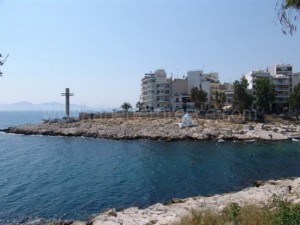
Υπάρχουν πολλές παραλίες στην Αθήνα, οι πιο δημοφιλείς από αυτές είναι στη Γλυφάδα, Βουλιαγμένη, Βάρκιζα, Νέα Μάκρη, Καβούρι και Αλιμο.
Το λεωφορείο για την Ραφήνα, περνάει από την Λούτσα και η Λούτσα προσφέρει μια πολύ όμορφη παραλία. Η Λούτσα είναι στον μισό δρόμο από την Αθήνα προς το αεροδρόμιο.
Η Ζούμπερί είναι μια ακόμη όμορφη παραλία, πολύ κοντά στη Ραφήνα, Από την Ραφήνα, αν πάρεις ταξί στο Ζούμπερι, θα πρέπει να σας κοστίσει 5 ευρώ το πολύ. Η παραλία είναι οργανωμένη και κατάλληλη για παιδιά, μπορείτε να σταματήσετε για ένα γεύμα στη ταβέρνα του Νικολά, η οποία είναι μια παραδοσιακή ταβέρνα μόλις 2 λεπτά με τα πόδια από την παραλία και ίσως μια από τις καλύτερες ταβέρνες στη περιοχή.
4. Τα αξιοθέατα στην Αθήνα
Η Αθήνα είναι η ιστορική πρωτεύουσα της Ευρώπης. Η Αθήνα έχει μια μακριά μακριά ιστορία, που χρονολογείται από τον πρώτο οικισμό στη νεολιθική εποχή. Τον 5ο αιώνα π.Χ. (Η χρυσή εποχή του Περικλή) – το αποκορύφωμα της μακριάς, συναρπαστικής ιστορίας της Αθήνας – οι αξίες και τον πολιτισμό της πόλης απέκτησαν παγκόσμια σημασία. Η πολιτική σκέψη, το θέατρο, οι τέχνες, η φιλοσοφία, η επιστήμη, η αρχιτεκτονική, μεταξύ άλλων μορφών διανόησης, έφτασαν στο επικό απόγειό, σε μια περίοδο πνευματικής ολοκλήρωση μοναδικό στην παγκόσμια ιστορία.
Η ακρόπολη: Ο ιερός βράχος της Αθήνας. Το φρουρίο και το ιερό της πόλης στην αρχαιότητα. Η ακρόπολη της Αθήνας είναι η πιο γνωστή ακρόπολη σε όλον τον κόσμο. Στο βραχώδη λόφο στο κέντρο της Αθήνας, βρισκέται το σπουδαιότερο και μεγαλοπρεπέστερο ιερό της αρχαίας πόλης, αφιερωμένο, κατά κύριο λόγο, στην προστάτιδα θεά της, την Αθηνά. Στον ιερό χώρο σχετίζονται οι σημαντικότεροι μύθοι της αρχαίας Αθήνας, οι μεγαλύτερες θρησκευτικές γιορτές, οι παλαιότερες λατρείες της πόλης αλλά και ορισμένα από τα καθοριστικά για την ιστορία της γεγονότα. Ο λόφος επιλέχθηκε ήδη από τα νεολιθικά χρόνια (4000/3500-3000 π.Χ.) ως τόπος εγκατάστασης των κατοίκων της περιοχής. Κατάλοιπα εγκατάστασης της Πρώιμης και Μέσης Εποχής του Χαλκού εντοπίσθηκαν στην περιοχή του Ερεχθείου. Η ακρόπολη είναι ανοιχτή προς επισκέπτες κάθεμερινά από τις 8 π. μ.μέχρι τις 5 μ.μ. Το εισητήριο για την ακρόπολη κοστίζει 12 ευρώ και σας επιτρέπει επίσης να επισκεφτείτε τον Ιερό του Διονύσου, τον Κεραμεικό, τον Ναό του Ολυμπίου Διός, την Αρχαία Αγορά και την Ρωμαική Αγορά εντός μιας εβδομάδας. Τηλ: +30 210 3214172 και +30 210 3236665
Ο ναός του Ολυμπίου Διός:
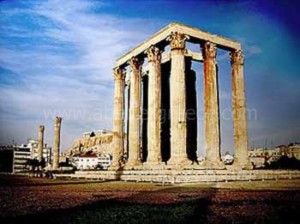
Ο ναός του Ολυμπίου Δίος είναι επίσης γνωστό και ως το Ολύμπείον, βρίσκεται σε απόσταση περίπου 500 μέτρα από την ακρόπολη, στην Λεωφόρο Αμαλίας. Ο ναός αποτελεί ένα από τα αρχαιότερα ακι σημαντικότερα ιερά της Αθήνας. Ο ναός ιδρύθηκε επάνω στα θεμέλια ενός αρχαίου υπαίθριο ιερό αφιερωμένο στο Δία, κατά την παράδοση που διέσωσε ο περιηγητής Παυσανίας, από τον Δευκαλίωνα γενάρχη των Ελλήνων προς τιμή του Δία ως αντάλλαγμα για τη σωτηρία του μετά τον μεγάλο κατακλυσμό.
Στην εποχή της τυραννίας, γύρω στο 515 π.Χ., ο Πεισίστρατος ο νεότερος εγγονός του τυράννου Πεισίστρατου, προσπάθησε να αντικαταστήσει το παλιό ναό με ένα νέο και πιο εντυπωσιακό ναό. Η τυραννία όμως, καταργήθηκε και οι κατασκευαστικές εργασίες τερματίστηκαν. Η κατασκευή του νέου ναού αργότερα συνεχίσθηκε από τον Βασιλέα της Συρίας, τον Αντίοχο τον Δ΄ τον Επιφανή, με τον Ρωμαίο αρχιτέκτονα τον Κοσσούτιο, το 175 π.Χ., Ο Αντίοχος πέθανε το 163 π.Χ. και η κατασκευή του ναού για άλλη μια φορά εγκαταλείφθηκε. Η κατασκευή δεν είχε στέγη και αέτωμα. Η κατασκευή του ναού, η οποία κατατάσσεται μεταξύ τα μεγαλύτερα στην αρχαιότητα, ολοκληρώθηκε το 131 μ.Χ. από τον Ρωμαίο αυτοκράτορα Αδριανό. Ο ναός είναι ανοιχτός προς επισκέπτες καθημερινά από τις 8 π.μ. μέχρι τις 5 μ.μ. και η είσοδος κοστίζει μόνο 2 ευρώ. Τηλ: +30 210 9226330
Κεραμείκος: Το νεκροτεφείο της αρχαίας Αθήνας, σήμερα, μια ανοιχτή γλυπτοθήκη που είναι ανοιχτό για επισκέπτες καθημερινά από τις 8 π.μ. μέχρι τις 5 μ.μ. και η είσοδος η οποία βρίσκεται επί την οδό Πειραιώς κοστίζει μόνο 2 ευρώ. Τηλ: +30 210 3463552
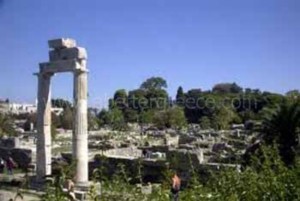
Η αρχαία αγορα: Η αρχαία αγορα της Αθήνας είναι το πιο γνωστό παράδειγμα τηε αρχαίας ελληνικής αγοράς, βρίσκεται βορειοδυτικά της ακρόπολης και είναι ανοιχτό για επισκέπτες καθημερινά από τις 8 π.μ. μέχρι τις 5 μ.μ. και η είσοδος κοστίζει μόνο 4 ευρώ. Τηλ: +30 210 3210185
Το θέατρο του Διόνυσου: Το θέατρο του Διόνυσος είναι το αρχαιότερο υπαίθριο θέατρο της Ελλάδας που είναι ανοιχτό για επισκέπτες καθημερινά από τις 8 π.μ. μέχρι τις 5 μ.μ. και η είσοδος η οποία βρίσκεται επί την οδό Πειραιώς κοστίζει μόνο 2 ευρώ. Τηλ: +30 210 3224625
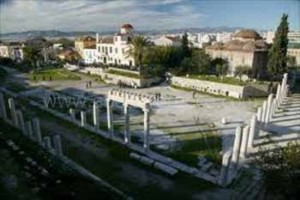
Η Ρωμαική αγορά: Η Ρωμαική αγορα (στη περιοχή της Πλάκας) ήταν ένα αρχιτεκτονικό συγκρότημα που χτίστηκε μεταξύ του 19ου και του 11ου αιώνα π.Χ. αποτελείται από ένα μεγάλο ορθογώνιο γήπεδο που περιβάλλεται από κιονοστοιχίες (στοά), ενώ διάφορα καταστήματα βρίσκονται μέσα στις στοές. Πίσω από τις στοές υπήρχαν διάφορα καταστήματα. Βόρεια του συγκροτήματος ήταν μια βιβλιοθήκη (ένα ορθογώνιο κτίριο: οι διαστάσεις του κτιρίου είναι 122 Χ 82 μέτρα), το οποίο χτίστηκε το 132 μ.Χ. από τις δωρεές του Ιουλίου Καίσαρα και του Αυγούστου. Είναι ανοιχτό για επισκέπτες καθημερινά από τις 8 π.μ. μέχρι τις 5 μ.μ. και η είσοδος κοστίζει μόνο 4 ευρώ.Τηλ: +30 210 3210185
Ο Άρειος Πάγος: Ο Άρειος Πάγος είναι το δικαστήριο της αρχαίας Αθήνας και το αρχαιότερο δικαστήριο του κόσμου. Ήταν η έδρα της πρώτης αριστοκρατικής συνέλευσης της αρχαίας Αθήνας. Το συγκρότημα σταδιακά έχασε την πολιτική επιρροή και στον δεύτερο μισό του 5ου αιώνα, διατήρησε μόνο τη λειτουργία του ως δικαστήριο, ως επί το πλείστον με υποθέσεις δολοφονίας. Η Ορέστεια περιγράφει η δίκη σε αυτό το δικαστήριο του Ορέστη για το φόνο της μητέρας του, την Κλυταιμνήστρα, και τον εραστή της, τον Αίγισθο. Ο Απόστολος Παύλος μίλησε στους Αθηναίους στον Αρείου Πάγο το 51 μ.Χ.. Μια χάλκινη πλάκα υπάρχει στη βάση του βράχου το οποίο τιμάει τα κηρύγματά του. Η είσοδος ειναι ελεύθερη για όλους.
Η κοιλάδα του Ιλισσού: Το επιζών τμήμα της κοιλάδας του ποταμού Ιλισού (κοντά στο ναό του Ολυμπίου Διός) αξίζει μια επίσκεψη. Στην αρχαιότητα ο ποταμός Ιλισσός ήταν γνωστό ως το ιερό ποταμό των Μουσών. Τα διάσπαρτα ερείπια των αρχαίων ιερών βρίσκεται στην κοιλάδα. Θα βρείτε σε κοντινή απόσταση, τον βράχο της πηγής της Καλλιρόης – η οποία ήταν πολύ γνωστή στην αρχαιότητα – και την εκκλησία της Αγίας Φωτεινής, που χτίστηκε το 1872 στη θέση ενός αρχαίου ναού, πάνω στα θεμέλια του ιερού ιερό της Εκάτης. Θα βρείτε σε κοντινή απόσταση, τα διατηρημένα μνημεία της κλασικής Ρωμαϊκής και Βυζαντινής Εποχής, μεταξύ άλλων, (ο ναός του Δελφινίου Απόλλωνα, ο ναός του Κρόνου και της Ρέας, μια βυζαντινή συνοικία με εργαστήρια, και η εκκλησία του Λεωνίδα).
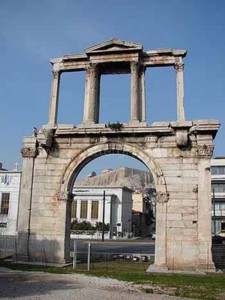
Η Πύλη του Αδριανού: Following the construction of the temple of Zeus, the Athenians, in 131 AD, in honor of Hadrian, built an arch on the northwestern perimeter of the temple. The entire monument is made of Pentelic marble, from Mt. Pentelikon, 18.2km northeast of the arch. Pentelic marble was used for the Parthenon and many other notable structures in Athens, although its quality can vary significantly. The marble used for the arch is of a lower grade that had more inclusions than that used in the best Athenian buildings. The arch was constructed without cement or mortar from solid marble, using clamps to connect the cut stones. It is 18m high, 13.5m wide, and 2.3m in depth. Its design is fully symmetrical from front to back and side to side. The arch bears two inscriptions on the architrave over the arch. One inscription, facing the Acropolis and the old town (facing West), says: ”This is Athens, the city of Theseus.” The other inscription, facing the sanctuary and an extension of Athens constructed by Hadrian (facing east), says: ” This is the city of Hadrian, not Theseus”.
Dionysiou Aeropaghitou Street: Dionysiou Aeropaghitou Street is one of the most impressive streets of Athens, offering a fantastic view of the rock of the acropolis and the Parthenon. Most of the buildings on one side of the road facing south were constructed in the late 19th century and the early 20th century in the neoclassical or modernist style, reflecting the bourgeois style of the street.
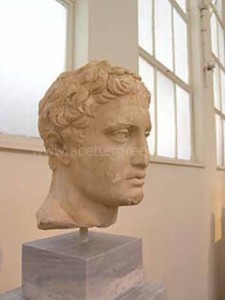
The Stoa of Eumenes: The Stoa of Eumenes is a stoa on the acropolis of Athens, sited between the Odeion of Herodes Atticus and the Theater of Dionysos. It was built against the slope of the hill (meaning it needed a retaining wall supported by piers and round arches. It is named after its builder, Eumenes II of Pergamum (whose brother Attalus II of Pergamum built the Stoa of Attalus in Athens’s agora, probably commissioning it from the same architect). It was two-storied, 46m longer than the Stoa of Attalus and unlike it had no rooms behind its two-aisle hall, meaning it was designed for promenading rather than business. Originally marble-faced, its arcades were built into the 1060 Byzantine defensive wall and are still visible. It had Doric columns externally, Ionic columns on the ground-floor interior and Pergemene-type capitals on the top floor interior. In front of the Stoa are the foundations of the 320BC Monument of Nikias.
The Odeion of Herodes Atticus: The Odeon of Herodes Atticus is a stone theatre structure located on the south slope of the Acropolis of Athens. It was built in 161 AD by Herodes Atticus, a teacher and a philosopher, in memory of his wife, Aspasia Annia Regilla. It was originally a steep-sloped amphitheater with a three-story stone front wall and a wooden roof, and was used as a venue for music concerts with a capacity of 5,000.
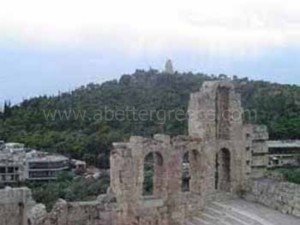
Philopappou hill: Philopappou hill is well worth a visit at any time of the year. A walk at Philopappou hill is a fasinating experiance: you will find here a unique copse, important monuments such as the thought to have been ”Prisons of Socrates”, the ”tombs of Kimon”, the ancient Koilis street, the ”Iroo Mousaiou,” the Philopappou monument and the spectacular view of the Parthenon and the Acropolis.
The sights: Philopappou Monument was built by Athenians in the 2nd century BC in honour of the benefactor, ruler of Syria, Gaius Julius Antiochus. Gaius Julius was also known as Philopappos, which roughly means ”beloved grandchild”. His grandfather was the last King of Kommagene Antiochus IV.
Cobbled road: In the 1950’s the Greek architect D. Pikionis developed the design of the area encompassing the Prolylaea of the Acropolis and Philopappou Hill. Take note of the hand made cobbled roads leading to the monuments, the church of Ayios Dimitrios Loumbardiaris and the refreshment room. This area has been designated a Scedualed and Protected Monument of the Global Cultural Heritage.
The pnyx: The pnyx is located between the hill of the muses (the location of Philopappou monument) and the hill of the nymphs, (The location of the Sancuary of the nymphs and the National Observatory). The Pnyx was the official meeting place of the Athenian democratic assembly (ekklesia). In the earliest days of Athenian democracy (after the reforms of Kleisthenes in 508 B.C.), the ekklesia met in the Agora. Sometime in the early 5th century, the meeting place was moved to a hill south and west of the Acropolis. This new meeting place came to be called “Pnyx” (from the Greek word meaning “tightly packed together”. Three phases can be distinguished:
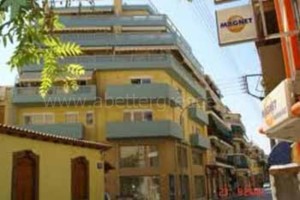
The Akademia Platonos: ( Plato’s academy) The area was settled in the prehistoric age (in the 6th century BC one of the three famous Gymnasia of Athens was founded here). It is named after the hero Akademos, or Ekademos. However, it is known after the famous philosophical school founded by Plato (neighborhood Akademia Platonos)in 387 BC . The school was a focal point of the prestigious Neoplatonist philosophers.
The sights:
The sacred Residence of the geometric years consists of seven rectangular spaces. it has the same features as the sacred residence of Eleusina. Remnants of sacrifices found at the residence seem to indicate that intensive worship took place here.
The Gymnasium. The Gymnasium is a large rectangular building (1st century BC-1st century AD), with an internal peristyle and rooms on the northern side. In the Gymnasium is a small area that served as an arena.
The Peristyle building. A large rectangular building (4th century BC) with an interior peristyle. It is thought to be an arena or an annex of the Gymnasium.
The early Greek Arched Residence. It consists of a hall, a chamber and a storage room. It is thought to be the prehistoric residence of Akademos.
BYZANTINE MONUMENTS IN ATHENS
The 11th and the 12th centuries are thought to be the Golden Age of Athens Byzantine art. Most of the better known and the more important Byzantine churches of Athens were built in these two centuries as part of a Christian reconstruction following the campaigns of Emperor Basil II in the Balkans. Some of the better known monasteries were also founded in the same period in the suburbs of Athens.
The old metropolois (The Old Cathedral) (Mitropoleos square)
This charming church is located near the new cathedral. It was built in the late 12th century. It is dedicated to Gorgoepikoos Panayia (the Virgin Mary) and Ayios Eleftherios. Ancient and Byzantine bas-reliefs were used for the construction of the church. In the facade is an ancient frieze taken from a monument of the 4th century BC depicting official attic festivals. The church was the official Episcopal Sea of Athens following the expulsion of the bishops from the Parthenon by the Franks and later the Turks. From 1839 to 1842 it was used as a library. The new metropolis nearby was built from 1842 and 1862 as the cathedral of Athens.It is a domed church built in the neobyzantine and neoclassical style.
Kapnikarea (Ermou Street)
The church of Kapnikarea is located on Ermou Street, between the squares of Syntagma and Monastiraki. Kapnikarea was built in the 11th Century on the ruins of another church that had been built in the 11th century.
This may explain the fact that the dome is held by four Roman pillars. In 1834, it was planned to be demolished, but with the timely intervention of King Ludwig I of Bavaria the demolition was avoided.
The church was renovated during the decade of 1950 by the University of Athens. During the renovation, the artist Fotis Kontoglou (1895-1965) created the majority of the icons that decorate the church, among them is one of the Virgin with the Child.
Church of Kapnikarea
Ermou & Kapnikareas
10556 Athens (Greece)
Tel. +30 210 – 3224462
Ayios Nikolaos Rangavas (Plaka)
Ayios Nikolaos Rangavas is located near the Anafiotika area of Plaka. The church was built in the 11th century. It was a part of the palace of the Rangavas family. Micheal I, Emperor of Byzantium, was descended from this family. The area around the church was formerly called Rangavas.
Ayia Ekaterini (Plaka)
Ayia Ekaterini is located near the Lysikrates Monument, in the square bearing the same name. Shading the church is a palm tree. it was constructed from 11th-12th century. In the corner of the square are the ruins of a Roamn monument.
Ayios Ioannis Theologos (Plaka)
Ayios Ioannis Theologos is a very beautiful cruciform church of the 11th – 12th century. It is located at the crossroads of Erotokritou Street and Erechtheos Street. It has been renovated several times.
Sorita tou Kotaki (Plaka)
Sorita tou Kotaki is better known as Ayia Sotira. It is located at Kydathenaeon Street, opposite the museum of Greek folk art, in the Plaka area. It was built in the 11th – 12th century. It has been renovated several times.
Metochi Panayiou Tafou (Anafiotika)
Metochi Panayiou Tafou is located at Erechtheos Street. It is a small monastery belonging to the holy Sepulchure of Jerusalem. The church of the monastery, Ayioi Anargyroi was built in the 17th century.
Panayia Chryssokasrriotissa (Anafiotika)
Panayia Chryssokasrriotissa is one of the several churches in Anafiotika. According to popular belief, the miraculous icon of the church protects believers in difficult circumstances.
Sotira Lykodimou – Russian Orthodox Church In Athens (Filellinon Street)
Sotira Lykodimou – Russian Church In Athens is the biggest medieval building in Athens. Built in 1031, it was part of a Roman Catholic monastery that closed in 1701. In the 1850’s the building was renovated by Tsar Alexander II who donated a bell tower. Sotiras Lykodimos is the Russian Orthodox Church of Athens.
Ayioi Apostoloi tou Solaki (Ancient Agora)
Ayioi Apostoloi tou Solaki is located in the compound of the Ancient Agora excavation. It is one of the oldest churches in Athens (1000 – 1025 AD). It was constructed on the ruins of a Roman nympheum of the 2nd century. In the 1950’s following a renovation, it was restored to its original form. Many post-Byzantine frescoes of church Ayios Spiridonas, which have been demolished, were transported to Ayioi Apostoloi.
Pantanassa (Monastiraki Square)
Pantanassa was built in the 10th century, the church belonged to the monastery of the Koimesi tis Theotokou. The neighbourhood was named after the monastery. Formely it was a monastery dependency of the Kaisariani Monastery.
Ayios Demetrios Loumbardiaris (Philopappou Hill)
Ayios Demetrios Loumbardiaris is a beautiful church of the 16th century, with remarkable frescoes. According to popular belief, the name (Loumbardiaris of Bombardiaris) was deviered from an incident that occured in the 17th century. Ayios Demetrios protected believers from a great cannon (Loumbarda).
Ayioi Asomatoi (Thission)
Ayioi Asomatoi is a cruciform church that was built in the 11th century, with carved stone blocks, framed by bricks, while in places subsequent Islamic influence is obvious.
Ayios Ioannis stin Kolona (Euripidou Street)
Ayios Ioannis stin Kolona is a small chapel built in the 12th century, it was named after a Roman column, preserved in the interior. Ayios Ioannis o Vaptistis was thought to be the healer of all sicknesses of the head. Visitors may see on the column offerings to the Saint offered by the faithful expressing gratitude for his help.
Ayioi Theodoroi (Klafthmonos square)
This church was reconstructed in the late 11th century on the foundation of a church that was built in the 9th century. It was built by N. Kalomaos, who was a Spatharocandidatos (a rank of the Byzantine Court).
Taxiarches (The church of the Petraki Monastery, at 14, Gennadiou Street)
Taxiarches was built in the 12th century, it belongs to the Petraki monastery (18th century). In the cross domed church visitors may see frescoes dating back to 1719.
Ayioi Isidoroi (Lycavitos Hill)
Ayioi Isidoroi is a small church located in a small cave on Lycavitos Hill. It was formerly called Ayios Sidereas church. It was burned down in 1930 and then was reconstructed in 1931.
Ayios Georgios (Lycavitos Hill)
Ayios Georgios is a whitewashed church at the top of Lycavitos hill. You can reach the church by foot or by funicular. It is thought that in antiquity the temple of Akraios Zeus was located here. In the period of the Frankish rule, the small chapel of Profitis Ilias was built here. Later Ayios Georgios the rider was built here. The excact date of the constuction of the church is not known. The church bell was donated by Queen Olga who put the ruin church under her protection.
OTTOMAN MONUMENTS IN ATHENS
Athens was conquered by the Ottomans in 1456 and liberated in 1833. Remarkable buildings of the Ottoman period have been preserved.
Mosques
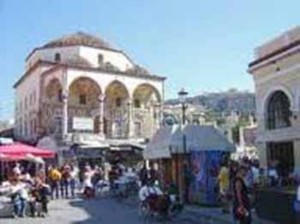
The Tzistrarakis mosques (Or Kato Sintrivaniou), located in Monastiraki Square, was built in 1759 by the Turkish voivod Moustafa Agas (or Tzistarakis). Seeking lime for the construction of the Mosque, Tzistarakis removed the 17th column of the temple of the Olympian Zeus. The Mosque has a logia with four columns and two rows of four windows on each side. Since 1981 it has housed the museum of Traditional Ceramics. In Athens there is only one Mosque open to the public, the Tzistarakis Mosque. Near the Roman Agora, is the remarkable Fetihie Mosque, built in 1458 in honour of Mohamed II the Conqueror, on the occasion of his visit to Athens.
Turkish Bath
The Old Bath (Hamam Abit Efendi), in Plaka (at 8 Kyrristou Street), built in the 17th century, was a popular meeting place in the Ottoman Era. The Old Bath has been renovated. It houses the personal hygiene at Toilet Museum.
Muslim Seminary
The gate of the Muslim Seminary, at the crossroads of Aeolou Street and Pelopida Street is the remains of the building, which destroyed in a fire in 1911. According to an inscription above the enterance, the seminary was built in 1721 and consisted of a main building, which was a school and a mosque, buildings housing the students and teachers (hodjia), kitchen and hygiene areas, and a central court.
The historical centre of Athens
Plaka
Plaka, is also known as the ‘neighbourhood of the gods’ is the oldest neighbourhood of Athens. Walking on its paved narrow streets, you get the feeling that you are travelling back in time. The origin of the name of this neighbourhood is unknown, although theories abound. According to popular belief Plaka was named after a slab of stone that was found near the church of Ayios Georgios Alexandrias, in the vicinity of the theatre of Dionysos. The beautiful neoclassical style colour of the houses, the architecture, the well kept gardens, and the beauty and atmosphere of the neighbourhood are enchanted. In Plaka, the air that you breathe is different, it is lighter, cleaner and fragrant like a gift of the gods. When you visit Plaka, you should bring a map because you could get lost in the labyrinth of narrow streets and alleys. In Andrianou Street, the central street of the neighbourhood, as in other streets in this area, you will find shops selling traditional Greek products, Greek souvernirs, Greek folkart and handicrafts etc.
The sights:
Philomousou Etaireias Square is the central square of the neighbourhood that was named after Philomousou Etaireia (The society of the friends of the Muses, in other words, the nine Gods of the arts), which was founded in 1813. The purpose of the society was the promotion of Greek studies and the preservation of archeological treasures of Athens. At the square, located at the crossroads of Kydathenaeon Street, Farmaki Street, Olympiou Dios Street and Angelou Geronta Street are a multitude of cafes, restaurants, clubs with live music and souvernir shops.
The Children’s museum of Athens is located upon Kydathenaeon Street is a wonderful place for children. In the attic is a reconstructed room with old furniture, a radio and theatre in the style of old Athenian homes, named ‘grand-dad and grand-mother’s room’ where children may dress with period dresses. The museum houses among others an exhibition of paintings by children, old toys, a fairground and a labrary. If you have children, be sure to visit the children’s museum. It is also worth seeing the neighbouring Museum of Greek Children’s art (9 Kodrou Street), which among other things, exhibits in its premises paintings and three dimensional art works by children up to 14 years old from all over Greece which are re-newed on a regular basis.
Lysikrates Monument. In ancient Athens, theatrical performances held at the theater of Dionysos were funded by wealthy citizens, the donors (choregoi). The city gave a prize to the donor of the winning performance. When the wealthy Lysikrates won the prize in 334 BC, he constructed a monument to house it. The monument is preserved (Ancient Tripodon Street – pavement of the road is preserved in a special space in a renovated building at number 28). The monument has had a long and varied history. In 1658, a Capuchin Monastery was founded here. In 1669, Capuchin’s bought the monument. Lord Byron stayed at the monastery in his second visit to Greece. In the gardens the cultivation of the tomato, at that time unknown in Greece, was introduced.
Anafiotika. On the foot hills of the acropolis has the charm of a beautiful island village, is was built in the mid 19th century by the renowned builders of the Aegean island of Anafi, who were invited to construct the palace of the first king of the Helenes, Otto. Feeling nostalgic for their birth place, in their long stay in Athens, they re-created it in the upper area of Plaka. They built small white washed houses, re-producing the architectural style of their village. We recommend that you visit Anafiotika, the neighborhood of the Anafiotes, a unique charming area.
The Museum of the University of Athens The building housing the museum of Athens, located at Tholou Street was formally the residence of the architect Kleathes (1832-1833). Subsequently it housed the first university of Athens (1837-1842).
The Kanellopoulos Museum of Athens Was founded in 1976, following the donation of the private collection of Pavlos and Alexandra Kanellopoulos to the Greek state. It is housed in the neoclassical mansion of the Mihalea family. The Kanellopoulos collection consists of archaeological finds and works of arts from the pre-historic era to the present.
Monastiraki
A distinctive ‘ old’ Athens area, with narrow irregularly criss-crossing streets and small buildings characteristic of Ottoman and to some extent Byzantine, urban planning. On the out door stands of street sellers, or the small shops on the central roads, you can find anything, such as shoes, clothes, old and new furniture, old books and magazines, souvenirs, jewelry, hats, bronze objects, new and used records and cds and traditional Greek instruments (bouzoukis, touberlaeki). Shopping or walking in Monastiraki is an unforgettable experience. You will be stunned by the variety and quality of the things that you can buy in the market.
The sights
Monastiraki Square At the historical square you will find the Tzistarakis mosque, Hadrian’s library, The Byzantine church of Pantanassa. Of particular interest also is the completely renovated neoclassical metro station – one of the oldest of the metro network (1895), where next to its platforms the encased bed of ancient Iridanos river is on display in a specially arranged area (300m2).
Avissinias Square (Giousouroum) This is the central square of Monastiraki. Here you will find a wide range of rare furniture, antiques and the copies of antiques, and a variety of used items. Moreover you will find old wardrobes, bookcases, frames, mirrors, antique office tables, tables, gramophone records and musical instruments. Come early if you want to shop. Noon is the best time to come if you want to take a look around. You can have a glass of Greek wine or ouzo with Greek snacks – that are called mezedes – in one of the small shops of the square, and observe the bustle of the bazaar.
Adrianou Street. A distinctive Athens Street, that connects Hadrian’s library with the ‘Theseio’ metro stop. In the neoclassical one-floor or two floor buildings are shops with traditional items, and antique shops. Street sellers sell their ware here Sundays. You will find here cafes and small fashionable restaurants with a unique view of the archeological area of the Ancient Agora.
The Old Commerce Centre of Athens.
The area encompassed by Metropoleos Street, Athinas Street and Stadiou Street is the ‘heart’ of the historical center of Athens, the old commercial area. In the area, with the smaller or larger labyrinthine streets, are more than 2 500 shops selling a wide range of products. Pedestrian zones have been established. The historic commercial centre is a rather quiet area, with a multitude of cafes, small bars and modern restaurants.
The sights:
Mitropoleos Street. Connects Syntagma Square with Monastiraki Square. The buildings on the street are built in the neoclassical style. The old Metropolis (The old Cathedral) dominates Mitropoleos Square. On the square are several cafes. In the colorful Dimopratiriou Square nearby you will find taverns with delicious traditional Greek food.
Ermou Street. This street is named after the God Hermes – the protector of trade. Ermou Street was one of the first streets paved by Kleanthes and Schaubert. More than 60 years, from the late 19th century to the 1960’s, it was a center of woman’s fashion. It is one of the best areas for shopping in the capital. You will find a variety of silver, among others, candle holders, bowls, vases and jewellery, often hand-made goods produced in Greece, in shops at Lekka Street, which connects to Perikleous Street and Kolokotroni Street and the nearby arcades. Also in the picturesque Evangelistrias and Ayiou Markou Streets, there are many shops selling clothing and shoes are at very reasonable prices. In the section of Ermou Street closest to Syntagma Square (up to Athina’s Street) you will find the Kapnikarea church. In the section of Ermou Street closest to Piraeus Street (From Thission to Piraeus Street) you will find the archaeological area of Kerameikos.
Athina’s Street. A central commercial road connecting Omonia square with Monastiraki Square, it was one of the first main roads constructed in modern Athens. Athinas Street is busy most times of the day. Most of the shops sell groceries. The fragrance of foods, fruits, herbs and nuts pervades the air. The street has the charms of the bazaars of the East. It faces the Acropolis. A multitude of important buildings of the 19th century and the early 20th century is located here. Recently the street has become a center for Fine Arts with more than ten art galleries in the area.
Athens Town Hall (63 Athinas Street): Athens Town hall was constructed in 1874 in a strictly neoclassical style. Originally a two-floor building, in 1937 a floor was added and the building was modified due to the increased space requirements of the Municipality of Athens. In the interior you will find the paintings of well known Greek painters of the 19th century, and frescoes of F.Kontoglou with representations of mythological and historic themes (1937 – 1940). You will find a large oil painting depicting the Apostle Paul teaching the Athenians Christian religion (1877) in the Municipal Coucil Hall. In the reception room (1st floor), you will find in special glass show-cases, small terra cotta figures representing all the mayors of Athens. In the vicinity of the municipality is an attractive, small square, Theatrou Square.
Kotzia Square ( Ethnikis Antistassis Square) was formely called Laou Square, and Loudovikou Square, faces the Town Hall. The eclectic style Melas Mansion (Ern. Ziller 1887), with an impressive facade, and two small towers at the sides, dominates the south side of the square. The central hall is covered with a glass roof. In the perimeter are Doric and Ionian style colonnades. The building, formally the residence of V. Melas, houses the Cultural Centre of the National bank of Greece. In the eastern side of the square is a renaissance style building, the G. Stavrou Mansion, housing services of the National bank of Greece. A section of the Acharnic Gate of the Themistocleian walls was uncovered and is exhibited in the north eastern section of the square.
Varvakeios Municipal (Central) Market is a rectangular building (1886) with a large covered court. There are a total of 73 food market stalls in the interior and exterior sections. This market is covered by a glass and a metal roof and has symmetrical windows. You will find here small restaurants with fresh food, attracting Athenians especially after midnight. There is a small grove on the square (Varvakeios square) across the street.
Evripidou Street is a charming street with an oriental atmosphere, that connects Koumoundourou Square with Klafthmonos Square. You will find here a multitude of shops selling spices, sweets, nuts, coffee, and traditional oriental products.
Aiolou Street A pedestrian zone has been established in a large section of the Aiolou Street, which connects Panepistimiou Street with the Roman Market (Plaka). At the crossroads of Aiolou Street and Sophocleous Street is the newly constructed Administration Building of the National Bank of Greece (2002), one of the most important modern architectural sights of Athens. The building was designed by Greek architects, with the collaboration of the famous architect M.Botta. On the ground floor you will find a restored section of the ancient Acharnai road. At 10 Sophocleous Street is the mansion of the Athens Stock Exchange, with a classical style facade and ten Doric style columns. As you head towards Plaka you will see two marvellous churches, which are well worth a visit: The Panayia Chrysopiliotissa (1863 – at the crossroads of Aiolou Street and Panayia Chrysospiliotissa Street) and Ayias Irinis Street (1847 – Athinaidos Street) both built by the architect L. Kaftantzoglou. Ayia Irini, which was the first Cathedral of Athens, is located at a colourful square, with flower shops and cafes.
Stadiou Street is a central street – one of the first paved roads of Modern Athens. It was built on a river bed. It was formely called Pheidou street and Akakiou street. There was a plan to extend the street to the Panathenaean Stadium – which was never put into action – hence the name Stadiou.
National Printers Building connects Santaroza street and Arsaki street. One of the first public mansions raised in the modern city (1834), it is built in the neoclassical style. Before 1905, it housed the National printers.
Klafthmonos Square is a spacious square with interesting buildings and a multitude of cafes. An impressionist bronze statue representing the ‘ National Reconciliation’ stands in the centre of this square.
Attikon – Apollon building is an ectectic style mansion. It houses two cinemas, among the oldest in Athens, which have recently been renovated.
Karytsi Square is a small square named after the church at its centre. The elegant church was built at the site of an older church where the Athenians in January 1833 selected a deputation to welcome the new king Otto in Nauplion. Opposite the square is the neoclassical style ‘Parnassos’ building.
Kolokotroni Square is a small square, with the National Historical Museum and the impressive statue of the hero of the Greek revolution Th. Kolokotronis on horseback (L.Sohos 1904) at its centre. Opposite the square is the dilapidated Douila Residence, one of the oldest buildings of the modern city, the work of Chr. Hansen.
Psyrri: A colorful neoclassical Athens neighborhood, encompassed by Athinas Street, Ermou Street, and Evripidou Street. It is a busy neighborhood, especially at night. You will find on its narrow alleys a multitude of cafes, small bars, clubs, restaurants etc Following the liberation of Greece (1833), veteran freedom fighters and immigrants from the provinces settled in the neighborhood. They opened cottage industries and workshops, which have given the neighborhood a distinctive character. In the early 1990’s following a series of construction works, the neighborhood became a popular nightlife and residential area. The churches in the area are also quite interesting, such as Ayioi Anargyroi, Ayios Demetrios, Ayios Grigorios (Armenian), et al. Iroon square, the central square, is a good place for you to start your walk.
Kerameikos: Near the archaeological area is the historic neighborhood of Kerameikos. Worth seeing are Ayion Assomaton Street, Melidoni street and Salaminas street. In recent years, the area has become one of Athens’s popular nightlife hubs with many small restaurants, bars and live-music nightclubs.
Gazi: The former Gas works is at the center of the neighborhood, which was formally called ‘ Gazohori’ (Gas village). Located in western Athens, it is the third square of the city, in accordance with the Kleanthes Schaubert urban plan. It has to a large extent maintained the color of a historic Athens neighborhood. You will find cafes, bars and luxury restaurants popular among Athenians, in a multitude of old, picturesque buildings.
Metaxourgeio: The historic neighborhood in the center of Athens was planned by architect, Chr. Hanson. The name id derived from a silk fabric manufacture factory, which closed in 1875 (the building which is preserved, is located at Meg. Alexandrou Street, between Mylerou Street and Giatrakou Street). On the one side of Achilleus Street, (facing Piraeus Street) is the old section and on the other side (facing Lenorman Street) is the new section. The new section which has been reconstructed, has not maintained the historic character of the neighbourhood, while in the old section a number of buildings constructed in the traditional style have been preserved. In the area are a multitude of small cafes and restaurants serving traditional oriental drinks, sweets, and food.
The sights:
Marble fountain. The marble fountain, located at Metaxourgeio square was built in the 19th century. It was transported here from Dimopratiriou square.
Iasonas Street and Yiatrakou street. Starting at Karaiskaki square, take Achilleus street, turn at Iasonas street and proceed to Agisilaou street. You will find here small theaters in historic buildings. Take a right turn at Academou – Yiatrakou street and proceed to Achilleus street. Take note of the small neoclassical (one-story and two-story) houses with balconies, balusters and ornate front doors. At the crossroads of Yiatrakou street and Germanikou street, you will find a small colorful square (Avdis square) with cafes, bars and a playground.
The Peloponnese railway station. Starting at Karaiskaki square, take a turn at Deligianni street and you will arrive at this colorful building, built in 1912 – 1913, with an architectural design combining the neoclassical, central European and Art Nouveau styles. The railway station is a copy in a reduce scale of the Constainopole railway station reflecting the European architectural trends of the 19th century. Opposite the Peloponnese railway station is the Larissas railway station (serving railway lines to central and northern Greece) built in 1908, in the neoclassical style and later reconstructed.
Kolonos: If you want to go for walk, you can visit Kolonos, a working class neighborhood of Athens near the historic center. Although the area has been re-built the neighborhood maintains its distinct historic character. Starting at Peloponnese railway station, take Ioannion Street, to Ippiou Kolonou Hill and (take a turn at Eurippou Street) proceed to Skouze hill. Around these small wooded hills, you will find an area of detached houses with gardens and small elegant blocks of flats, preserving the atmosphere of the old Athens neighborhood (the nearest metro stop is ‘Sepolia’ ).
Makriyianni: A residential area enclosed by the Dionysiou Aeropaghitou street to the foothills of Philopappou Hill. The neoclassical houses and the newer buildings, (especially buildings built in the interwar era) are charming. Makriyianni is one of the most elegant neighborhoods of the city. Worth a visit are, among others Mitseon Street, Parthenonas street, Webster street, Cavalloti street, Kallisperi street, R. Gali street, Mouson Street.
The sights:
Acropolis research centre is a stately building. The building is adorned with Byzantine style masonry with neoclassical decorative motifs. It was built in 1834 by German architect, W. von Weiller. Formelly a military hospital and a base of police units, it has housed the ‘Acropolis Research Centre’ sice 1987. The new Acropolis Museum is being constructed in a nearby place.
Koukaki: Neighboring Makriyanni is Koukaki, a colorful neighborhood, especially the area near Philopappou hill ( Panaitoliou street, Arakinthou street).
Ano Petralona: A charming colorful neighborhood, excluding the atmosphere of 1950’s Athens. Several examples of working-class urban architecture are preserved, among others, one-story and two story houses.
The sights
Dora Stratou Theater is located west of the hill (ancient Amphitheater). You can see performances of Greek folk dances by Dora Stratou dance group. Dora Stratou dedicated her life to the research and preservation of Greek folk art. The group, which has participated in a multitude of festivals worldwide, is known in Greece and abroad. The dancers wear traditional Greek costumes of various regions of the country, and preform songs and dances of all periods of Greece’s history.
Mercouri square is a colorful square, with small cafes, and traditional taverns in the nearby streets.
Stone built houses. An attractive, small neighborhood-in the area of Aginoros street and Troon street with stone built houses, (of the postwar period), excluding the atmosphere of a mountain village, is being re-developed.
Thission (Theseion): The area was named after the nearby ancient temple. A traditional neighbourhood with a multitude of charming neoclassical houses and public mansions. Have a drink at one of the outdoor cafes at Thission Square (at Apostlou Pavlou street) and enjoy a unique view of the Acropolis and the Ancient Agora area.
The sights:
D.Aiginitou street. Connects Apostolou Pavlou street with the National Observatory. It has a unique view of the Acropolis, Lycabettus Hill, the Ancient Agora and the new city.
National Observatory. The oldest research institution of Greece and the Balkans, was founded in 1842. The building of the observatory at Nymphon Hill, opposite the Acropolis and the Ancient Agora, was designed by Th. Hansen. It is an attractive neoclassical building. The building is cruciform, facing the four compass points.
Ayia Marina square is a colorful, quiet square with the church of AAyia Marina in the centre. In the northwestern side, sculpted into the rock, is the original chapel, with a posterior dome and frescoes of the 13th century.
Thission Park is the northwestern section of the Ancient Agora archeological area. It was planted with trees in 1862 and ornamental plants in 1931. Formely it was the area where the Athenians celebrated Easter.
Poulopoulos Hatfactory (66 Iraklion street is a noteworthy industrial building with an interesting masonry and a tiled roof. The building, an important landmark that housed a hatfactory many years, is a schedualed building. The space is used for various purposes(‘Melina Merkouri Cultural Centre).
Kolonaki: Kolonaki is situated at an exclusive location, encompassed by Syntagma square, Vassilisis Sofias Avenue, and the slopes of Lycabettus hill. It was named after the old Greek column (in Greek language the word kolonaki means a small column), in the center of Kolonaki Square. The area was not developed before the 1880’s. In Kolonaki you will find parks and attractive buildings, built predominantly in the neoclassical and modernist architectural style, lending the area a distinguished character. It is considered the ‘ aristocratic’ area of Athens. Here you will find the most expensive commercial shops, popular cafes, luxury restaurants and modern bars. If you seek diversion and relaxation and go for a stroll at Patriarchou Ioakim street, Tsakalou street, Anagnostopoulou street, Milioni street, Fokylidou street, Karneadou street, Loukianou street, Ploutarchou street, Haritos street, Spefsipou street and the Lykabettos circular. When you vivst Athens, you should have a coffee at one of the cafes in Kolonaki Square. Modern Athenians and foreign visitors enjoy their break at one of the cafes, eating, drinking coffee and chatting.
The sights
Dexamenis square is a small square, which serves as a local recreation ground. The traditional cafe on the square attracts Athenians and visitors. It used to be the meeting place of the intellectuals in the 20th century. Here you will also find an old aqueduct and an outdoor cinema.
Skoufa street is the central street of Kolonaki, with interesting neoclassical and art deco style buildings. In the section from Kolonaki square to Delfon street are a multitude of shops and modern cafe-restaurants.
Ayios Dionysios (Skoufa street) is a stately church, was built in the 1930’s at the site of an earlier church. The facade is built in a neo-renaissance style, and the interior is decorated in the Byzantine style. Ayios Dionysos Areopagitis, one of Athens’ early Christians, is the patron saint of Athens.
Lycavittos square is located near Ayios Dionysios. Dominating the square is the Dragoumis Mansion (1925), a private residence, which formely accommodated the Brazilian Embassy.
Marasleio. The ‘ Marasleio College of education of state education’ an attractive neoclassic building, is the work of architect D. Kallias (1905).
Voukourestiou street distinctive Athens road, it connects the foot of Lycavittos hill with Syntagma square. In the pedestrian zone, you will find a multitude of cafes and bars.
Taxiarches, the church of Petraki Monastery in Kolonaki.
Gennadis library. Impressive building in the classicist style, which was inaugurated in 1926 to house the book collection donated in 1922 by scholar I. Gennadios to the American school of Classical studies in Athens. In 1960 the building was expanded. It is surrounded by a large garden with lush vegetation.
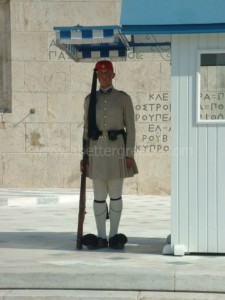
Syntagma square: Syntagma Square is Athens’ central square. The name of the square is derived from an uprising on 3 September 1843, of the people and the guard of Athens before the then palace building, demanding that King Otto grant a Consitution (Syntagma means constitution). Syntagma square and Omonoia square are the two central locations of the city. You should not be surprised if when you ask for directions, people refer to Syntagma square. Plaka, the acropolis, the Cathedral, the National Garden, Ermou street and Kolonaki, are located in the vicinity of Syntagma square.
The sights
The parliament. Dominating Syntagma square, the building was the residence of the first king of Greece Otto. The building was constructed from 1836 to 1842. George A’, who succeeded Otto on the throne, also resided in the palace. During his reign, two successive fires destroyed the building, making it unsuitable for use as a royal residence. In 1924 the government decided to situate Parliament in the building. Reconstruction work was completed in 1934. The interior was redesigned by architect A. Kriezis. In Parliament you will find national treasures, such as the first Greek Constitution, and a multitude of valuable paintings. The library is worth a visit.
Monument of the Unknown solider Built from 1929-1932, in front of Parliament, it is a sculpted depiction of a slain soldier (the work of sculptor K. Dimitriades), bearing an inscription with excerpts of Pericle’s Epitaph. Commemorated on the marble wall surrounding the monument are the greatest battles of the Greek army posterior to 1821. Gra and visiting officials lay a wreath at the monument on national holidays. The monument is guarded around the clock by two select trooa called Evzones who wear the traditional uniform. The ceremony of the changing of the guard, which takes place every hour, is worth seeing, especially on Sunday morning (11 a.m.), when it is accompanied by a military band and a large regiment of Evzones.
Grande Bretagne Hotel is a luxury hotel, built in 1842. The building, designed as a private residence, was the work of Th. Hansen. Renovated in 1874, it accommodated a hoi In 195 8 the hotel was reconstructed to meet increasing demand, and several floors were added to the structure. In 2003 the building was com pletely renovated. The hotel connected to major events of Greek history. A multitude notables and celebrities visits Athens stayed here. Worth a visit is the interior, with a cafe and luxury restaurant, excluding a unique atmosphere.
Ancient aqueduct. A section of the ancient cemetery and Peisitstratos aqueduct, unearthed in the northeastern section of the square, is displayed in an outdoor, covered area.
Philellinon street is a prolongation of Stadiou street. You will find here attractive neoclassical buildings and, at the crossroads of Philellinon street. Xenophontos street and Souri street the Sotira Lykodimou church and the Anglican church of saint Paul (1843), the work of Ch. Hansen, with elements of the Gothic style and cruciform shape.
Amalias Avenue is a broad avenue connecting Hadrian’s Arch with Syntagma square. An elegant street with stately neoclassical and modernist buildings, it is located in the vicinity of the National Gardens. As you ascend towards Syntagma square, you will have a view of the Parliament and, in the distance, Lycavittos hill.
National garden: The National Garden (formerly the Royal Garden) (Greek: Εθνικός Κήπος) is a public park of 15.5 hectares in the center of the Greek capital, Athens. It is located directly behind the Greek Parliament building (The Old Palace) and continues to the South to the area where the Zappeion is located, across from the Panathenaiko or Kalimarmaro Olympic Stadium of the 1896 Olympic Games. The Garden also encloses some ancient ruins, tambourines and Corinthian capitals of columns, mosaics, and other features. On the Southeast side are the busts of Capodistrias, the first governor of Greece, and of the Philhellene Jean-Gabriel Eynard. On the South side are the busts of the celebrated Greek poets Dionysios Solomos , author of the Greek National Hymn, and Aristotelis Valaoritis.
The sights
Zappeion museum. The Zappeion is one of the most important buildings of Athens next to the National Garden, its construction was financed by Evangelos Zappas. The neoclassical mansion is inherent with the modern history of Greece and now is used for public and private exhibitions and ceremonies. In 1869 the Greek government donated 80,000 square meters of public land for the building of Zapeion in the area between the palace, the gardens and the ancient Temple of Zeus. The Greek Parliament also passed a legislation on 30th of November 1869 specifically for the construction of buildings for the Olympic Games in 1896, the Zappeion was the world’s first building that was built exclusively for the Olympic Games.
The Rigillis area: A prestigious area with luxury residential buildings, villas and abundant vegetation. It is encompassed by Vassilisis Sofias Avenue, Rigillis street, Vassileos Konstantinou Avenue and Irodou Attikou street. The area is located in the vicinity of the old palace (now known as the Presidential Mansion).
The sights
Presidential Mansion (Herodou Attikou Street) The former loyal palace was built in the neoclassical and eclectic style (1890-1897) by the architect Ern. Ziller. Formerly it was used as the residence of princes crown princes, later as a palace, and in 1974 as the official residence of the President of the Hellenic Republic. It has an attractive garden. The mansion is guarded by Evzones, wearing a distinctive uniform.
Maximou Mansion (Herodou Attikou street) is the official workplace of the Prime Minister. Kolonaki, the most expensive shopping district in Athens, lies immediately to the north, the National Gardens to the west and the Panathenaic Stadium to the southeast. The barracks of the Evzones of the Presidential Guard are the only buildings on the western (National Garden) side of the street. The street is heavily guarded round the clock.
The statues, The sculptures at the junction of Herodou Attikou street are among the most attractive in Athens: the discus thrower, a bronze statue by K.Dimitriades (1927), the marble wood-chopper by D. Filippotis, 1872-1875 – gymnast V.Yiannoulis posed for the work – and the statue of G. Karaiskakis, a bronze monumental sculpture by M. Tombros (1963-1966), depicting a hero of the Greek revolution on horseback.
Panathenaikon stadium (Kallimarmaro): The Panathinaiko or Panathenaic Stadium (Greek: Παναθηναϊκό στάδιο), also known as the Kallimarmaro (Καλλιμάρμαρο, i.e. the “beautifully marbled”), is an athletic stadium in Athens that hosted the first modern Olympic Games in 1896. Reconstructed from the remains of the ancient Greek stadium, the Panathinaiko is the only major stadium in the world built entirely of white marble (from Mount Penteli).
In ancient times, it was used to host the athletic portion of the Panathenaic Games, in honour of the Goddess Athena. During classical times, the stadium had wooden seating. It was remade in marble, by the archon Lycurgus, in 329 BC and was enlarged and renovated by Herodes Atticus, in 140 AD, to a seated capacity of 50,000. The remnants of the ancient structure were excavated and refurbished, with funds provided by Evangelis Zappas for the revival of the Olympic Games. Evangelis Zappas sponsored the Olympic Games that were held there in 1870 and 1875. The stadium was refurbished a second time in 1895 for the 1896 Olympics, with completion funding provided by the Greek benefactor George Averoff (whose marble statue now stands at the entrance), based on designs by architects Anastasios Metaxas and Ernst Ziller.
Mets: One of the most fashionable neighborhood of Athens, was developed in the 1870’s. It was named after the Mets brewery that was located in the area, and decades it was a popular recreational area. In the 1950’s on the riverbed of the Ilissos river passed through it. Today it is a quiet residential area, encompassed by the Ardittou hill and the 1st cemetery. In the central road of the area, M. Mousourou street are cafes. Worth seeing are other distinctive roads of the neighbourhood. If you take Kleitomachou street, Archimidou street you will reach Varnava square. Here you will find cafes, traditional taverns and luxury restaurants. You can return to the Panathenaikon Stadium via Agras street.
1st cemetery: It is the oldest and the biggest cemetery of Athens. Several important personalities of modern Greece have been laid to rest here. The foundation of the cemetery coincided with the foundation of the modern Greek state. The design recalls the major cemeteries of Western Europe in the early 1900’s. It is basically an outdoor sculpture display, with a stately and serne garden, excellent monumental tombstones, built by some of the most important Greek sculptors of the past two centuries.
Lycavittos hill: Is sometimes referred to as Lycabettos or Lykabettos, is the highest point in Athens, rising 910 feet above the city. Because of its height, it is a landmark visible from almost every part of the capital (ill. 7-9). Its name reflects a popular belief that the hill was inhabited by wolves. Another legend explains that Lykavittos hill appeared when Athena accidentally dropped a large rock she was going to use for the construction of the Acropolis. Despite these interesting legends, Lykavittos did not attract the attention of classical authors and historians. However, the majestic peak is an important tourist destination. A small whitewashed chapel of St. George, erected in the 19th century on the site of a Byzantine church of Prophet Elijah, crowns the top of Lykavittos. From the top one can see a panorama of the entire city and the theater, used for concerts and spectacles. To reach the top by foot, you need to prepare yourself for a long climb. The initial portion of the climb, among shrubs and small trees, is relatively easy. However, when you get to the zigzagging stairs, laid out at a low angle to make the ascent easier (but longer!), your legs are going to let you know they are not too happy about the exercise. If you don’t feel like arguing with them, choose an easier way — take the funicular from Kolonaki. After you reach the top, you may rest and have a drink in a terraced restaurant or let the wind on the observation deck cool you down.
Neapoli: Neopoli is encompassed by Lycavittos Hill and Mavromihali street. It is after Plaka, the oldest neighborhood in Athens (Neopoli in Greek means new town). Neapoli and Exarrhia were developed in 1860. The first residents were mostly students. The area is situated near the University and the Polytechnic. Later it became a favorite residential neighborhood of artists. At Asklipiou is the remarkable neoclassical church of Ayios Nikolaos Pefkakion (1895). Facing Lycavittos hill, is an area on a steep incline, with a pedestrian zone, lined with trees and steps leading to the central roads where you will find among others, a multitude of cafes, small book shops and antique shops.
Exarhia
Strefi hill
Panepistimiou avenue
Omonoia square
Patision street
Kypseli
Vassilisis Sofias avenue
5. Οι πόλεις της Αθήνας
θα ειναι συντομα κοντα σασ!!!!
6. Η ιστορία και η μυθολογία της Αθήνας

Athens is one of the oldest named cities in the world, having been continuously inhabited for at least 7000 years. Situated in southern Europe, Athens became the leading city of Ancient Greece in the first millennium BCE and its cultural achievements during the 5th century BCE laid the foundations of western civilization. During the early Middle Ages, they experienced a decline, then recovered under the later Byzantine Empire and was relatively prosperous during the period of the Crusades (12th and 13th centuries), benefiting from Italian trade. Following a period of sharp decline under the rule of the Ottoman Empire, Athens re-emerged in the 19th century as the capital of the independent Greek state.
Etymology
The name of Athens (Attic: Ἀθῆναι Athḗnai, Doric: Ἀθᾶναι Athânai, Homeric: Ἀθήνη Athḗnē) derives from goddess Athena, its patron goddess. The word originates from an earlier, Pre-Greek language. The etiological myth explaining how Athens acquired this name through the legendary contest between Poseidon and Athena was described by Herodotus, Apollodorus, Ovid, Plutarch, Pausanias and more. It even became the theme of the sculpture on the West pediment of the Parthenon. Both Athena and Poseidon requested to be patrons of the city and to give their name to it, so they competed with one another for the honour, offering the city one gift each. Poseidon produced a spring by striking the ground with his trident, symbolizing naval power. Athena created the olive tree, symbolizing peace and prosperity. The Athenians, under their ruler Cecrops, accepted the olive tree and named the city after Athena. The sacred olive-tree of goddess Athena seems to have survived for many centuries. It was located by the temple of Pandrosus, next to the Parthenon. During the Persian Wars, the olive tree was burnt together with the other sacred precinct, but according to Herodotus a shoot sprung from the stump. So the tree grew up again and survived until the time of Pausanias, i.e. to the 2nd century AD, as he reported in his “Description of Greece, Attica”.
In Plato’s dialogue Cratylus, he gives the etymology of the goddess Athena’s name based on the view of the ancient Athenians:
| “The ancients seem to have had the same opinion about Athena as do contemporary experts on Homer. Many of them say in their interpretations of the poet that he represents Athena as Understanding or Thought. The maker of names seems to think the same sort of thing about the goddess… and indeed calls her by a still higher title, “divine intelligence” [theou noesis], as though he would say: This is she who has the mind better than others. Nor shall we be far wrong in supposing that the author of it wished to identify this Goddess with moral intelligence [en ethei noesin], and therefore gave her the name ethonoe; which, however, either he or his successors have altered into what they thought a nicer form, and called her Athene“. |
| Plato, Cratylus, 407b |
Thus for Plato, Athena’s name is to be derived from the Greek Ētheonóa (Ή-θεο-νόα) or Atheonóa (Ἀθεονόα) — from god’s (theos) mind (nous).
Athḗnai is a plural form, the Athḗnai, since it was originally a group of ten cities which Theseus unified into one city.
Geographical setting
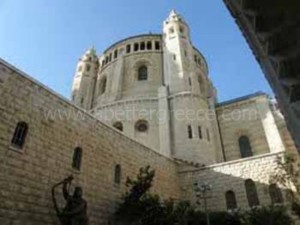
The site on which Athens stands was first inhabited in the Neolithic period, perhaps as a defensible settlement on top of the Acropolis (‘high city’), around the end of the fourth millennium BC or a little later. The Acropolis is a natural defensive position which commands the surrounding plains. The settlement was about 20 km (12 mi) inland from the Saronic Gulf, in the centre of the Cephisian Plain, a fertile valley surrounded by rivers. To the east lies Mount Hymettus, to the north Mount Pentelicus.
Ancient Athens, in the first millennium BC, occupied a very small area compared to the sprawling metropolis of modern Athens. The ancient walled city encompassed an area measuring about 2 km (1 mi) from east to west and slightly less than that from north to south, although at its peak the ancient city had suburbs extending well beyond these walls. The Acropolis was situated just south of the center of this walled area. The Agora, the commercial and social center of the city, lay about 400 m (1,312 ft) north of the Acropolis, in what is now the Monastiraki district. The hill of the Pnyx, where the Athenian Assembly met, lay at the western end of the city. The Eridanus (Ηριδανός) river flowed through the city.
One of the most important religious sites in ancient Athens was the Temple of Athena, known today as the Parthenon, which stood on top of the Acropolis, where its evocative ruins still stand. Two other major religious sites, the Temple of Hephaestus (which is still largely intact) and the Temple of Olympian Zeus or Olympeion (once the largest temple in mainland Greece but now in ruins) also lay within the city walls.
According to the Ancient Greek historian Thucydides, the Athenian citizens at the beginning of the Peloponnesian War (5th century BC) numbered 40,000, making with their families a total of 140,000 people in all. The metics, i.e. those who did not have citizen rights and paid for the right to reside in Athens, numbered a further 70,000, whilst slaves were estimated at between 150,000 to 400,000. Hence, approximately a tenth of the population were adult male citizens, eligible to meet and vote in the Assembly and be elected to office. After the conquests of Alexander the Great in the 4th century BC, the city’s population began to decrease as Greeks migrated to the Hellenistic empires in the East.
Origins and early history of Athens
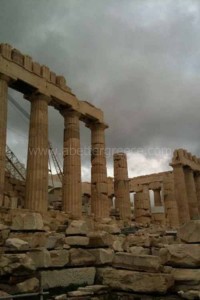
Athens has been inhabited from Neolithic times, possibly from the end of the 4th millennium BC. By 1400 BC the settlement had become an important center of the Mycenaean civilization and the Acropolis was the site of a major Mycenaean fortress whose remains can be recognised from sections of the characteristic Cyclopean walls. On the summit of the Acropolis, below the later Erechtheion, cuttings in the rock have been identified as the location of a Mycenaean palace. Between 1250 and 1200 BC a staircase was built down a cleft in the rock to reach a protected water supply, in a similar way to ones at Mycenae and Tiryns. Unlike other Mycenaean centers, such as Mycenae and Pylos, we do not know whether Athens suffered destruction in about 1200 BC, an event often attributed to a Dorian invasion, and the Athenians always maintained that they were “pure” Ionians with no Dorian element. However, Athens, like many other Bronze Age settlements, went into economic decline for around 150 years following this.
Iron Age burials, in the Kerameikos and other locations, are often richly provided for and demonstrate that from 900 BC onwards Athens was one of the leading centres of trade and prosperity in the region; as were Lefkandi in Euboea and Knossos in Crete. This position may well have resulted from its central location in the Greek world, its secure stronghold on the Acropolis and its access to the sea, which gave it a natural advantage over inland rivals such as Thebes and Sparta.
According to legend, Athens was formerly ruled by kings (see Kings of Athens), a situation which may have continued up until the 9th century BC. From later accounts, it is believed that these kings stood at the head of a land-owning aristocracy known as the Eupatridae (the ‘well-born’), whose instrument of government was a Council which met on the Hill of Ares, called the Areopagus and appointed the chief city officials, the archons and the polemarch (commander-in-chief).
Before the concept of the political state arose, four tribes based upon family relationships dominated the area. The members had certain rights, privileges, and obligations:
Common religious rights.
A common burial place.
Mutual rights of succession to property of deceased members.
Reciprocal obligations of help, defense and redress of injuries.
The right to intermarry in the gens in the cases of orphan daughters and heiresses.
The possession of common property, an archon, and a treasurer.
The limitation of descent to the male line.
The obligation not to marry in the gens except in specified cases.
The right to adopt strangers into the gens.
The right to elect and depose its chiefs.
During this period, Athens succeeded in bringing the other towns of Attica under its rule. This process of synoikismos – the bringing together into one home – created the largest and wealthiest state on the Greek mainland, but it also created a larger class of people excluded from political life by the nobility. By the 7th century BC social unrest had become widespread, and the Areopagus appointed Draco to draft a strict new code of law (hence the word ‘draconian’). When this failed, they appointed Solon, with a mandate to create a new constitution (in 594 BC).
Reform and democracy
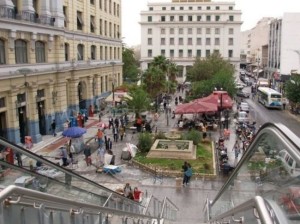
The reforms that Solon initiated dealt with both political and economic issues. The economic power of the Eupatridae was reduced by forbidding the enslavement of Athenian citizens as a punishment for debt, by breaking up large landed estates and freeing up trade and commerce, which allowed the emergence of a prosperous urban trading class. Politically, Solon divided the Athenians into four classes, based on their wealth and their ability to perform military service. The poorest class, the Thetai, (Ancient Greek Θήται) who formed the majority of the population, received political rights for the first time and were able to vote in the Ecclesia (Assembly). But only the upper classes could hold political office. The Areopagus continued to exist but its powers were reduced.
The new system laid the foundations for what eventually became Athenian democracy, but in the short-term it failed to quell class conflict and after 20 years of unrest the popular party, led by Peisistratus, a cousin of Solon, seized power (in 541 BC). Peisistratus is usually called a tyrant, but the Greek word tyrannos does not mean a cruel and despotic ruler, merely one who took power by force. Peisistratus was in fact a very popular ruler, who made Athens wealthy, powerful, and a centre of culture, and instituted Athenian naval supremacy in the Aegean Sea and beyond. He preserved the Solonian constitution, but made sure that he and his family held all the offices of state.
Peisistratus died in 527 BC and was succeeded by his sons Hippias and Hipparchus. They proved to be much less adept rulers and in 514 BC, Hipparchus was assassinated in a private dispute over a young man (see Harmodius and Aristogeiton). This led Hippias to establish a real dictatorship, which proved very unpopular and he was overthrown, with the help of an army from Sparta, in 510 BC. A radical politician with an aristocratic background named Cleisthenes then took charge, and it was he who established democracy in Athens.
The reforms of Cleisthenes replaced the traditional four “tribes” (phyle) with ten new ones, named after legendary heroes and having no class basis; they were in fact electorates. Each ‘tribe’ was in turn divided into three ‘trittyes’ and each trittys had one or more demes, which became the basis of local government. The tribes each elected fifty members to the Boule, a council which governed Athens on a day-to-day basis. The Assembly was open to all citizens and was both a legislature and a supreme court, except in murder cases and religious matters, which became the only remaining functions of the Areopagus. Most offices were filled by lot, although the ten strategoi (generals) were elected. This system remained remarkably stable and, with a few brief interruptions, it remained in place for 170 years, until Alexander the Great conquered Athens in 338 BC.
Classical Athens
Early Athenian military history
Prior to the rise of Athens, Sparta considered itself to be the leader of the Greeks, or hegemony. In 499 BC Athens sent troops to aid the Ionian Greeks of Asia Minor, who were rebelling against the Persian Empire (the Ionian Revolt). This provoked two Persian invasions on Greece (see Persian Wars). In 490 BC the Athenians, led by the soldier-statesman Miltiades, defeated the first invasion of the Persians under Darius I at the Battle of Marathon. In 480 BC the Persians returned under Darius’s son Xerxes. When a small Greek force holding the pass of Thermopylae was defeated, the Athenians evacuated Athens, which was taken by the Persians. Subsequently the Athenians (led by Themistocles), with their allies, engaged the much larger Persian navy at sea in the Battle of Salamis. Xerxes built a throne on the coast in order to watch the Greek navy being defeated, but instead, the Persians were routed.
In 479 BC, the Athenians and Spartans, with their allies, defeated the Persian army at the Battle of Plataea. However, it was Athens that took the war to Asia Minor. These victories enabled it to bring most of the Aegean and many other parts of Greece together in the Delian League, an Athenian-dominated alliance.
Artists and philosophers

The period from the end of the Persian Wars to the Macedonian conquest marked the zenith of Athens as a center of literature, philosophy (Greek philosophy) and the arts (Greek theater). In Athens at this time, the political satire of the Comic poets at the theatres had a remarkable influence on public opinion. Some of the most important figures of Western cultural and intellectual history lived in Athens during this period: the dramatists Aeschylus, Aristophanes, Euripides and Sophocles, the philosophers Aristotle, Plato and Socrates, the historians Herodotus, Thucydides and Xenophon, the poet Simonides and the sculptor Phidias, The leading statesman of this period was Pericles, who used the tribute paid by the members of the Delian League to build the Parthenon and other great monuments of classical Athens. The city became, in Pericles’s words, “the school of Hellas [Greece].”
Peloponnesian War
The resentment felt by other cities at the hegemony of Athens led to the Peloponnesian War, which began in 431 BC and pitted Athens and its increasingly rebellious overseas empire against a coalition of land-based states led by Sparta. The conflict led to the end of Athenian command of the sea. The war between the two city-states ended in a victory for Sparta.
During the second year of the Peloponnesian War, the city-state of Athens was hit by a devastating epidemic, known as the Plague of Athens, which killed, among others, Pericles and his two elder sons. Athens lost perhaps one third of the people sheltered within its walls.
Athenian coup of 411 BC
The democracy in Athens was briefly overthrown by a coup in 411 BC, due to its poor handling of the war, but it was quickly restored. The war ended in 404 BC with the complete defeat of Athens. Since the loss of the war was largely blamed on democratic politicians such as Cleon and Cleophon, there was a brief reaction against democracy, aided by the Spartan army (the rule of the Thirty Tyrants). In 403 BC, however, democracy was restored by Thrasybulus and an amnesty declared.
Corinthian War and the Second Athenian League
Sparta’s former allies soon turned against her, due to her imperialist policy, and soon Athens’ former enemies Thebes and Corinth had become her allies; they fought with Athens and Argos against Sparta in the indecisive Corinthian War (395 – 387 BC). Opposition to Sparta enabled Athens to establish a Second Athenian League. Finally Thebes defeated Sparta in 371 BC in the Battle of Leuctra. But then the Greek cities (including Athens and Sparta) turned against Thebes, whose dominance was stopped at the Battle of Mantinea (362 BC) with the death of its military-genius leader Epaminondas.
Athens under Macedon
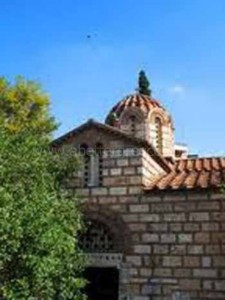
By the mid-4th century BC, however, the northern Greek kingdom of Macedon was becoming dominant in Athenian affairs, despite the warnings of the last great statesman of independent Athens, Demosthenes. In 338 BC the armies of Philip II defeated the other Greek cities at the Battle of Chaeronea, effectively ending Athenian independence. Subsequently, the conquests of his son Alexander the Great widened Greek horizons and made the traditional Greek city state obsolete. Athens remained a wealthy city with a brilliant cultural life, but ceased to be an independent power.In the 2nd century BC, after 200 years of Macedonian supremacy, Greece was absorbed into the Roman Republic.
Η Ρωμαικη Αθήνα
In 88 – 85 BC, most Athenian buildings, both houses and fortifications, were leveled by the Roman general Sulla, although many civic buildings and monuments were left intact. Under Rome, Athens was given the status of a free city because of its widely admired schools. The Roman emperor Hadrian, in the 2nd century AD, constructed a library, a gymnasium, an aqueduct which is still in use, several temples and sanctuaries, a bridge and financed the completion of the Temple of Olympian Zeus.
The city was sacked by the Heruli in AD 267, resulting in the burning of all the public buildings, the plundering of the lower city and the damaging of the Agora and Acropolis. After this the city to the north of the Acropolis was hastily refortified on a smaller scale, with the Agora left outside the walls. Athens remained a centre of learning and philosophy during its 500 years of Roman rule, patronized by emperors such as Nero and Hadrian. But the conversion of the Empire to Christianity ended the city’s role as a centre of pagan learning; the Emperor Justinian closed the schools of philosophy in AD 529. This is generally taken to mark the end of the ancient history of Athens.
Byzantine Athens
By AD 529, Athens was under the rule of the Byzantines and was no longer as revered as she had once been. The Parthenon, Erechtheion and the Hephaisteion (Theseion) were converted into churches. During the period of the Byzantine Empire, Athens was a provincial town and experienced fluctuating fortunes. In the early years of Byzantine rule, many of its works of art were taken by the emperors to Constantinople. From about AD 600 the city shrank considerably, due to barbarian raids by the Avars and Slavs, and it was reduced to a shadow of its former self. As the 7th century progressed, much of Greece was overrun by Slavic peoples from the north, and Athens entered a period of uncertainty and insecurity. The one notable figure from this period is the Empress Irene of Athens, a native Athenian, who seized control of the Byzantine Empire in a palace coup.
By the middle of the 9th century, Greece had been fully reconquered by the Byzantine Empire and the city began to recover. Just as other cities benefited from improved security and the restoration of effective central control during this period, so Athens expanded once more.
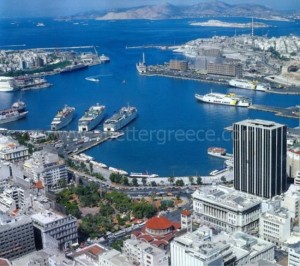
Invasion of the empire by the Turks after the battle of Manzikert in 1071, and the ensuing civil wars, largely passed the region by and Athens continued its provincial existence unharmed. When the Byzantine Empire was rescued by the resolute leadership of the three Komnenos emperors Alexios, John and Manuel, Attica and the rest of Greece prospered. Archaeological evidence tells us that the medieval town experienced a period of rapid and sustained growth, starting in the 11th century and continuing until the end of the 12th century. The agora or marketplace, which had been deserted since late antiquity, began to be built over, and soon the town became an important centre for the production of soaps and dyes. The growth of the town attracted the Venetians, and various other traders who frequented the ports of the Aegean, to Athens. This interest in trade appears to have further increased the economic prosperity of the town.
The 11th and 12th centuries were the Golden Age of Byzantine art in Athens. Almost all of the most important Middle Byzantine churches in and around Athens were built during these two centuries, and this reflects the growth of the town in general. However, this medieval prosperity was not to last. In 1204, the Fourth Crusade conquered Athens and the city was not recovered from the Latins before it was taken by the Ottoman Turks. It did not become Greek in government again until the 19th century.
Latin Athens
From 1204 until 1458, Athens was ruled by Latins in three separate periods.
Burgundian period
Athens was initially the capital of the eponymous Duchy of Athens, a fief of the Latin Empire which replaced Byzantium. After Thebes became a possession of the Latin dukes, which were of the Burgundian family called De la Roche, it replaced Athens as the capital and seat of government, although Athens remained the most influential ecclesiastical centre in the duchy and site of a prime fortress. Under the Burgundian dukes, a bell tower was added to the Parthenon. The Burgundians brought chivalry and tournaments to Athens; they also fortified the Acropolis. They were themselves influenced by Byzantine Greek culture.
Catalan period
In 1311, Athens was conquered by the Catalan Company, a band of mercenaries called almogávares. It was held by the Catalans until 1388. After 1379, when Thebes was lost, Athens became the capital of the duchy again.
The history of Catalan Athens, called Cetines (rarely Athenes) by the conquerors, is obscure. Athens was a veguería with its own castellan, captain, and veguer. At some point during the Catalan period, the Acropolis was further fortified and the Athenian archdiocese received an extra two suffragan sees.
Florentine period
In 1388, the Florentine Nerio I Acciajuoli took the city and made himself duke. The Florentines had to dispute the city with the Republic of Venice, but they ultimately emerged victorious after seven years of Venetian rule (1395–1402). The descendants of Nerio I Acciajuoli ruled the city (as their capital) until the Turkish conquest of 1458. It was the last Latin state in Greece to fall.
Ottoman Athens
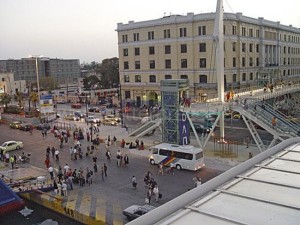
Finally, in 1458, Athens fell to the Ottoman Empire. As the Ottoman Sultan Mehmet II the Conqueror rode into the city, he was greatly struck by the beauty of its ancient monuments and issued a firman (imperial edict) forbidding their looting or destruction, on pain of death. The Parthenon was converted into Athens’ main mosque. The 375-year Ottoman rule of Athens (and of Greece in general) was the longest by any non-Hellenic power since the Romans.
Despite the initial efforts of the Ottoman authorities to turn Athens into a model provincial capital, the city’s population severely declined and by the 17th century the city was little more than a village. Great damage to Athens was caused during this time, as the Ottoman power was declining. The Turks began a practice of storing gun powder and explosives in the Parthenon and Propylaea. In 1640, a lighting bolt struck the Propylaea, causing its destruction. In 1687, Athens was besieged by the Venetians during the Morean War, and the temple of Athena Nike was dismantled by the Ottomans to fortify the Parthenon. A shot fired during the bombardment of the Acropolis caused a powder magazine in the Parthenon to explode, and the building was severely damaged, giving it the appearance we see today. The occupation of the Acropolis continued for six months and both the Venetians and the Ottomans participated in the looting of the Parthenon. One of its western pediments was removed, causing even more damage to the structure. The following year, Turkish forces set fire to the city. Ancient monuments were destroyed to provide material for a new wall which the Ottomans built around the city in 1778. Between 1801 and 1805 Lord Elgin, the British ambassador to the Ottoman Empire, arranged for the removal of many sculptures from the Parthenon (the Elgin marbles). Along with the Panathenaic frieze, one of the six caryatids of the Erechtheion was extracted and replaced with a plaster mold. All in all, fifty pieces of sculpture were carried away, including three fragments purchased by the French.
Nevertheless, Athens produced some notable intellectuals during this era, such as Demetrius Chalcondyles (1424–1511), who became a celebrated Renaissance teacher of Greek and of Platonic philosophy in Italy. Chalcondyles published the first printed editions of Homer (in 1488), of Isocrates (in 1493), and of the Suda lexicon (in 1499), and a Greek grammar (Erotemata). His cousin Laonicus Chalcondyles (c. 1423 – 1490) was also a native of Athens, a notable scholar and Byzantine historian and one of the most valuable of the later Greek historians. He was the author of the valuable work Historiarum Demonstrationes (Demonstrations of History) and was a great admirer of the ancient writer Herodotus, encouraging the interest of contemporary Italian humanists in that ancient historian. In the 17th century, Athenian-born Leonardos Philaras (c. 1595 – 1673), was a Greek scholar, politician, diplomat, advisor and the Duke of Parma’s ambassador to the French court, spending much of his career trying to persuade western European intellectuals to support Greek indepencence.
Independence from the Ottomans
In 1822, a Greek insurgency captured the city, but it fell to the Ottomans again in 1826. Again the ancient monuments suffered badly. Partially funded by Lord Byron, the Greeks continued to fight, but the Ottoman forces remained in possession until 1833, when they withdrew. Athens was chosen to be the capital of the newly established kingdom of Greece. At that time, the city was virtually uninhabited, being merely a cluster of buildings at the foot of the Acropolis, where the Plaka district is now.
Modern Athens
In 1832, Otto, Prince of Bavaria, was proclaimed King of Greece. He adopted the Greek spelling of his name, King Othon, as well as Greek national dress, and made it one of his first tasks as king to conduct a detailed archaeological and topographical survey of Athens, his new capital. He assigned Gustav Eduard Schaubert and Stamatios Kleanthes to complete this task.[17] At that time, Athens had a population of only 4,000 – 5,000 people, located in what today covers the district of Plaka in Athens.
Athens was chosen as the Greek capital for historical and sentimental reasons. There are few buildings dating from the period of the Byzantine Empire or the 18th century. Once the capital was established, a modern city plan was laid out and public buildings were erected. The finest legacy of this period are the buildings of the University of Athens (1837), the Old Royal Palace (now the Greek Parliament Building) (1843), the National Gardens of Athens (1840), the National Library of Greece (1842), the Greek National Academy (1885), the Zappeion Exhibition Hall (1878), the Old Parliament Building (1858), the New Royal Palace (now the Presidential Palace) (1897) and the Athens Town Hall (1874).
7. Ενοικιαζόμενα αυτοκίνητα στην Αθήνα
| 24 Hours Travel Service – Car Rental Greece | +302106964000 +302106964000 | Athens |
| ABROAD RENT A CAR | +302109242189 +302109242189 | Athens |
| ACE RENT A CAR | +302109680700 +302109680700 | Glyfada |
| ACROPOLIS RENT A CAR | +302109319682 +302109319682 | Athens |
| ADA RENT-A-CAR | +302103220087 +302103220087 | Athens |
| AI-ANSA INTERNATIONAL RENT A CAR | +302109243582 +302109243582 | Athens |
| ANTENA RENT A CAR | +302106084150 +302106084150 | Agia Paraskevi |
| APOLLO RENT A CAR | +302105249330 +302105249330 | Athens |
| ARENA RENT A CAR | +302108944215 +302108944215 | Glyka Nera |
| ARIMAR TAVEL & CAR RENT | +302108940423 +302108940423 | Glyfada |
| ASSET RENT A CAR | +302104287373 +302104287373 | Piraeus |
| ASTRA RENT A CAR | +302109220333 +302109220333 | Athens |
| AUTO UNION | +302109221211 +302109221211 | Athens |
| AUTOLEASE S.A. RENT A CAR | +302109885260 +302109885260 | Alimos |
| AUTORENT RENT A CAR | +302109232514 +302109232514 | Athens |
| AVANCE CAR RENTAL | +302109200100 +302109200100 | Athens |
| AVANCE RENT Α CAR -MOTO | +302109200100 +302109200100 | Athens |
| AVANTI RENT A CAR | +302109233919 +302109233919 | Athens |
| AVENTURA CAR RENTAL | +302109215805 +302109215805 | Athens |
| AVIS | +302106879800 +302106879800 | Athens |
| AXON LEASE Car & Van Rental Ltd | +302109210964 +302109210964 | Avlona |
| BAZAAR CAR RENTAL | +302109222000 +302109222000 | Athens |
| BUDGET | +302108981444 +302108981444 | Glyfada |
| BUDGET RENT A CAR – HELLAS | +302130213120 +302130213120 | Chalandri |
| CAPITAL RENT A CAR | +302109218830 +302109218830 | Athens |
| CITY SIGHTSEEING ATHENS | +30 210 9220604 +30 210 9220604 | Athens |
| CLIO RENT A CAR | +302109680131 +302109680131 | Glyfada |
| CONCORD RENT A CAR | +302109215267 +302109215267 | Athens |
| CORFU RENT A CAR | +302109230808 +302109230808 | Athens |
| EUROPCAR | +302102882000 +302102882000 | Nea Filadelfeia |
| EUROPEAN RENT A CAR | +302109233200 +302109233200 | Athens |
| FORCE HELLAS LTD | +302109228837 +302109228837 | Athens |
| HERTZ | +302106264000 +302106264000 | Kifissia |
| KOSMOS RENT A CAR | +302109234697 +302109234697 | Athens |
| LOTUS CAR RENTAL | +302109238440 +302109238440 | Athens |
| LUXURY CARS FOR RENT | +302109226666 +302109226666 | Athens |
| MINI RENT A CAR | +302104523777 +302104523777 | Piraeus |
| MOTORENT | +30 2109234939 +30 2109234939 | Athens |
| PAYLESS CAR RENTAL | +302299063211 +302299063211 | Athens |
| PEGASUS RENT A CAR | +302108946519 +302108946519 | Voula |
| POP’s CAR HELLAS | +302106626360 +302106626360 | Athens |
| RELIABLE INTERNATIONAL RENT A CAR | +302109249000 +302109249000 | Athens |
| SAFE WAY | +302105786064 +302105786064 | Peristeri |
| SIXT RENT A CAR | +302105770006 +302105770006 | Peristeri |
| SMART MOVING MEDIA HELLAS LTD | +308001176278 | Kifissia |
| THRIFTY Car Rental | +302106634211 +302106634211 | Spata |
| TOMASO RENT A CAR | +302107474000 +302107474000 | Athens |
ΠΡΟΣΟΧΗ
Οταν ενοικιαζετε οχημα σε οποιοδηποτε νησι, πρωτου υπογραψετε το συμβόλαιο, διαβαστε προσεχτικα τα μικρα γραμματα τα οποια βρισκονται στη πισω πλευρα του συμβολαιου.
Ελεξτε προσεχτικα την κατασταση του οχηματος πριν το παρετε, αν υπαρχουν προηγουμενες ζημιες οπως γρατζουνιες, εσωτερικες ζημιες κ.τ.λ πειτε τα στον υπαλληλο ωστε να εχει υποψην του για να μη πληρωσετε εσεις τις ξενες ζημιες.
Ο ελαχιστος χρονος ενοικιασης οχηματος ειναι 24 ωρες και στη τιμη συμπεριλαμβανεται και το Φ.Π.Α
Δεν δινουμε οχηματα χωρις το απαραίτητο διπλωμα οδηγησης.
Προσπαθήσαμε να σας μαζέψουμε όσες πιο πολλές πληροφορίες για το νησί και θα προσπαθήσουμε εμείς οι ίδιες να κάνουμε τη διαμονή σας στο νησί μας αξέχαστη. Αν χρειαστειτε κάτι το οποίο δεν υπαρχει ή δεν το βρίσκετε, σας παρακαλώ επικοινωνήστε με το information@abettergreece.com ή στα τηλέφωνα +30 6934620501 / +30 22840 24879 και θα χαρούμε να σας ακουσουμε.
8. Χρησίμες πληροφορίες για την Αθήνα
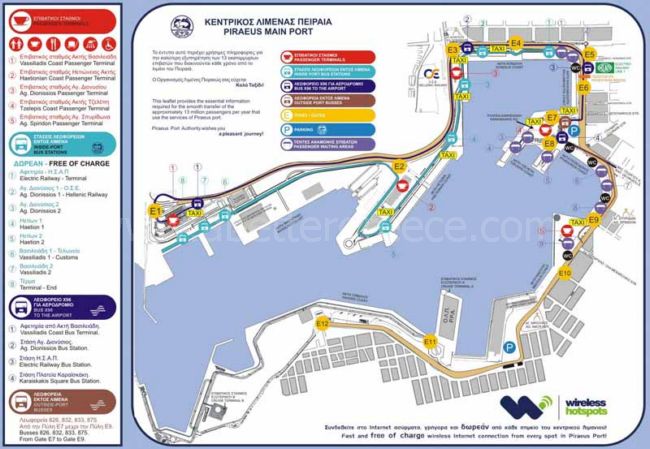
THE ARCHITECTURE OF MODERN ATHENS
Neoclassicism architecture in Athens: Neoclassicism was from 1834 to the 1920’s the predominant architectural style of the small city – which was situated in what is today the historical center. The style of neoclassicism, which was in vogue in Western Europe, was a product of the romantic fascination with antiquity. It was introduced by German architects who came to Greece in the early 1830’s to plan Athens. In the interwar era and especially after 1955, a number of Athens’ neoclassical buildings were torn down. However, in many areas of the historical centre, the charming, neoclassical style has been preserved.
Eclecticism architecture in Athens: In the late 19th century the tradition of neoclassicism was enriched by the romantic aesthetic, usually following the French style. Although Athenian classicism remained the predominant architectural style, public and private buildings were constructed in this period in a breezy style, influenced by the decorative style in vogue in Western Europe.
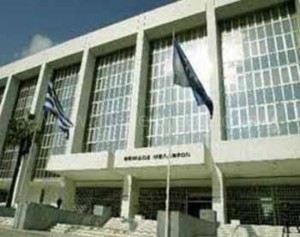
Art Nouveau: This radical movement was not established as a major architectural trend in Athens. However, after 1920, Greek bourgeois from Smyrna, Egypt and Constantinople constructed residences following the art nouveau style. The few, impressive art nouveau buildings contrasted with the uniform neoclassical and eclectic architecture prevailing in Athens.
The modernist movement: In the early 1930’s buildings with more than two or three floors – the usual number of floors of buildings at the time – were constructed. These small blocks of flats, which sometimes had six floors, introduced a Greek variety of the international modernist architectural style (Bauhaus, Art Deco). The main characteristic of buildings constructed in this period ( as well as the preceding period), are the semicircular ledges, and the facades. A multitude of these buildings are thought to be important monuments exemplifying the global history of the modernist style.
The post-war era (1950 – 2000): In the post-war era, the population of Athens and demand for housing rapidly increased. In the 1950’s and the early 1960’s buildings with marble facades, parapets, and imposing entrances were in vogue. From 1960 – 1975 (the development era) the mass construction of dull modern buildings was in vogue, altering the physiognomy of the new neighbourhoods. Quality buildings were also constructed in this era. In the past few decades, following a periodof stagnation, Athens has aquired important new (predominantly public) buildings, giving the city a new spendour, and upgrading depressed areas.
